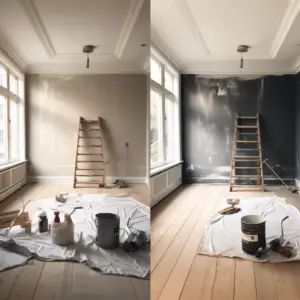Mastering Room Painting: Tips for Perfect Transformations, Tired of seeing the same walls? Ready for a new look? Painting a room is the answer! Here’s how to make it happen.
- Gather the supplies: paint brushes, rollers, drop cloths, and painter’s tape. Remove any furniture that could get in the way.
- Start by cleaning the walls and filling any holes or cracks with Spackle. Then apply primer to create an even base. Allow it to dry.
- Now choose a paint color! Consider the atmosphere you want to create. Lighter shades can make a space appear bigger and airy. Darker hues add warmth and coziness. Get creative with different finishes.
- Time to paint! Cut in along corners and edges with a brush. Use a roller for larger areas. Apply two coats of paint and let each one dry before applying the next. Don’t forget to protect floors and trim with painter’s tape.
- Take a step back and admire your work. The transformation is amazing! Not only will the room be new and fresh, but you’ll feel proud of your accomplishment.
Grab those brushes and get creative! Paint away those walls and create a room that reflects your style. Let’s go!

Table of Contents
Planning and Preparation
Ready to paint your walls perfectly? Let’s dive in and plan! Here are 6 key steps for success.
- Assess the space: Check size, shape, & condition. Note any repairs needed & potential obstacles.
- Choose colors that fit your mood or style. Think about lighting, room use, & existing furniture.
- Prepare the surfaces: Clean off dust, dirt, & grease. Sand rough spots & fill in dents with paste.
- Protect adjacent areas: Cover furniture, flooring, & trim with cloths & tape.
- Gather tools: Brushes, rollers, mixing trays, & high-quality paints.
- Plan your approach: Consider accessibility & layout. Start from top or bottom with consistent strokes.
Plus:
- Apps offer virtual room simulations.
- Get advice on trendy colors.
- Opt for eco-friendly paints.
Ancient Egyptians painted their walls with skill. They planned color palettes & fixed surfaces with mud & straw. This wisdom still helps us today. Planning & prep are key to great results!
Surface Preparation
- Clean the walls with a damp cloth or sponge to get rid of dirt, dust or grease.
- Check for cracks, holes or unevenness. Fill these with spackle or putty and let them dry.
- Sand for a smooth texture to help the paint stick.
- Scrape off old wallpaper or peeling paint with a scraper.
- Put on protective goggles and gloves.
- Apply painter’s tape around areas you won’t paint. It’ll give clean lines and avoid smudges or drips.
- A primer coat before painting can help the colour stay on better.
- Also, pay attention to the surface type – drywall, wood etc. Read the product instructions for both surface preparation and paint.
- Remember: Take your time with the surface prep – it’s important to get a flawless finish!
Priming the Walls
Priming the walls before painting is key. To do this, follow these 6 steps:
- Clean the walls. Use a mild detergent and water solution to remove dust, loose paint, and debris. Let it dry.
- Patch and repair holes and cracks. Fill with spackling paste and smooth it out with a knife. Sand the patched areas.
- Protect surfaces. Cover switches, outlets, baseboards, and floors with painter’s tape and drop cloths.
- Select the right primer. Consider stain-blocking ability and surface requirements.
- Apply primer. Cut in around edges and corners with a brush. Use a roller for larger wall surfaces in a “W” or “M” motion.
- Allow drying time. Follow manufacturer’s instructions.
Ventilation is important while priming due to its odor and fumes. Wear protective equipment like gloves and goggles.
Priming creates an ideal surface for paint adhesion, prevents stains, and helps with color consistency. Don’t skip this step if you want a professional finish!
Paint Selection
When it comes to painting a room, selecting the right paint is key. Think about the color, finish, and quality of the paint to get the desired outcome. Different rooms may require different types of paint, so choose wisely.
Be mindful of the color you choose. It can massively affect the room’s overall ambiance and style. Opt for a bold statement or a subtle nuance, but make sure it fits your desired aesthetic.
The finish of your paint can decide how easy it is to clean and maintain. High gloss is more durable and easier to wipe down, while matte looks more refined but may require touch-ups over time.
Investing in high-quality paint will give better coverage and last longer. Cheaper paints may not satisfy you and may need multiple coats for coverage.
When selecting paint, think about natural lighting, room size, and purpose. Lighter tones create an illusion of space, darker shades add coziness and warmth.
Painting rooms has come a long way. Ancient folks used animal fats and pigments, while Romans used minerals like iron oxide. Now we have a wide array of options for paint selection. By considering color, finish, and quality, you can get a beautiful result that lasts.
Painting Techniques
To become a painting pro, it’s vital to understand and put into practice different techniques. Here are some to consider:
- Brush Strokes: Use lengthy, gentle brush strokes to get an equal finish.
- Cutting In: Utilize a small brush to paint cautiously around edges and corners.
- Rolling: Utilize a roller for large areas for fast and even coverage.
To dodge mistakes in painting, try these tips:
- Prep Work: Take the time to clean surfaces, repair any flaws and use primer if needed.
- Quality Tools: Buy good quality brushes and rollers for a smoother application.
- Test Color: Before starting, test the paint color in a small area to see if it fits your vision.
- Multiple Coats: Apply multiple thin coats rather than one heavy coat for an even finish.
- Seamless Paint Edges: To dodge visible lines where different strokes meet, blend each stroke into the previous one.
By applying these techniques and advice, you can get professional-looking results while dodging typical errors. Have fun painting!
Clean-Up and Finishing Touches

After painting, it’s time to finish up! Make sure your room looks its best by tidying up and adding final touches. Follow these five steps for a perfect finish:
- Peel painter’s tape off windows, doors, and trim at a 45-degree angle.
- Wipe down any dust with a damp cloth or sponge. Pay attention to corners, baseboards, and windowsills.
- Sand down any drips or smudges with fine-grit sandpaper.
- Touch up any missed spots or uneven coverage with small amounts of paint.
- Replace furniture, decor, and switch plate covers. Step back and admire your room!
To take it a step further, use touch-up paint pens, clean brushes properly, and dispose of leftover paint and materials responsibly.
Don’t miss out on achieving a flawless finish! Take action now and transform your space into a masterpiece!
Conclusion
To sum up, painting a room demands close consideration and implementation. By following this guide’s steps, you can create professional-looking end results. Transform any area into a personal haven!
Here, we checked the fundamental prepping and techniques for successful room painting. Selecting the correct supplies and materials, as well as priming the walls properly, every point is critical for getting a flawless finish.
Also, we discussed the necessity of forbearance and attention to detail when applying paint. Even, smooth strokes are essential to avoid unsightly brush marks or drips that can spoil the room’s look.
Finally, it’s worth noting that smart color choices can make a huge difference in the atmosphere and feeling of your space. As Jane Smith, a prominent color specialist, states in her book “The Art of Color”, certain shades can produce different emotions and bring balance to a room.
Frequently Asked Questions
1. What supplies do I need to paint a room?
To paint a room, you will need the following supplies:
- Paint rollers and brushes
- Drop cloths or plastic sheets to protect the floor and furniture
- Tape to cover trim and edges
- Sandpaper for preparing the walls
- Painter’s tape
- Paint trays and liners
- Paint primer
- Paint of your choice
- Extension pole for hard-to-reach areas
- Paint stirrers and openers
- Rags or paper towels for clean-up
2. How do I prepare the room before painting?
Before painting a room, it is important to prepare the space:
- Remove all furniture from the room or cover it with plastic sheets.
- Clean the walls to remove any dust, dirt, or grease.
- Use painter’s tape to cover moldings, trim, and edges you don’t want to paint.
- Fill any holes or cracks in the walls with Spackle and sand them down.
- Apply a coat of primer to the walls, especially if they are a different color or have stains.
- Remove electrical outlet covers and light switch plates.
3. What is the best technique for painting walls?
To achieve smooth and even walls, follow these steps:
- Start by cutting in the edges and corners of the room with a brush.
- Use a roller to apply paint to the larger areas of the wall, working in sections.
- Roll in a “W” or “M” shape to evenly distribute the paint.
- Apply a second coat after the first coat has dried completely.
- Take breaks to ensure the paint dries evenly and to prevent streaks.
4. How do I choose the right paint color for my room?
Selecting the right paint color can greatly affect the ambiance of a room:
- Consider the purpose and mood of the room. Do you want it to be relaxing, energizing, or neutral?
- Take into account the room’s lighting, as natural and artificial light can alter the appearance of colors.
- Test paint swatches on the walls to see how they look in different lighting conditions.
- Take inspiration from existing furniture, décor, or artwork in the room.
- Consider using color palettes or consulting with a professional at a paint store.
5. How long does it take for paint to dry?
Drying times can vary depending on various factors, such as humidity, temperature, and type of paint. In general, latex or water-based paints dry faster than oil-based paints. Allow at least 2-4 hours for the first coat to dry before applying a second coat. It’s recommended to wait 24 hours before moving furniture back into the room or removing painter’s tape to avoid any damage to the freshly painted walls.
6. How do I clean up after painting?
Cleaning up after painting is essential to maintain your tools and keep the space tidy:
- Remove painter’s tape gently while the paint is still slightly wet to avoid peeling.
- Rinse paintbrushes and rollers with warm soapy water for latex paints or paint thinner for oil-based paints.
- Wipe down paint trays and liners with disposable rags or paper towels.
- Dispose of any used paint cans or containers properly as per local regulations.
- Remove drop cloths or plastic sheets and vacuum or sweep the area to remove any paint dust or debris.